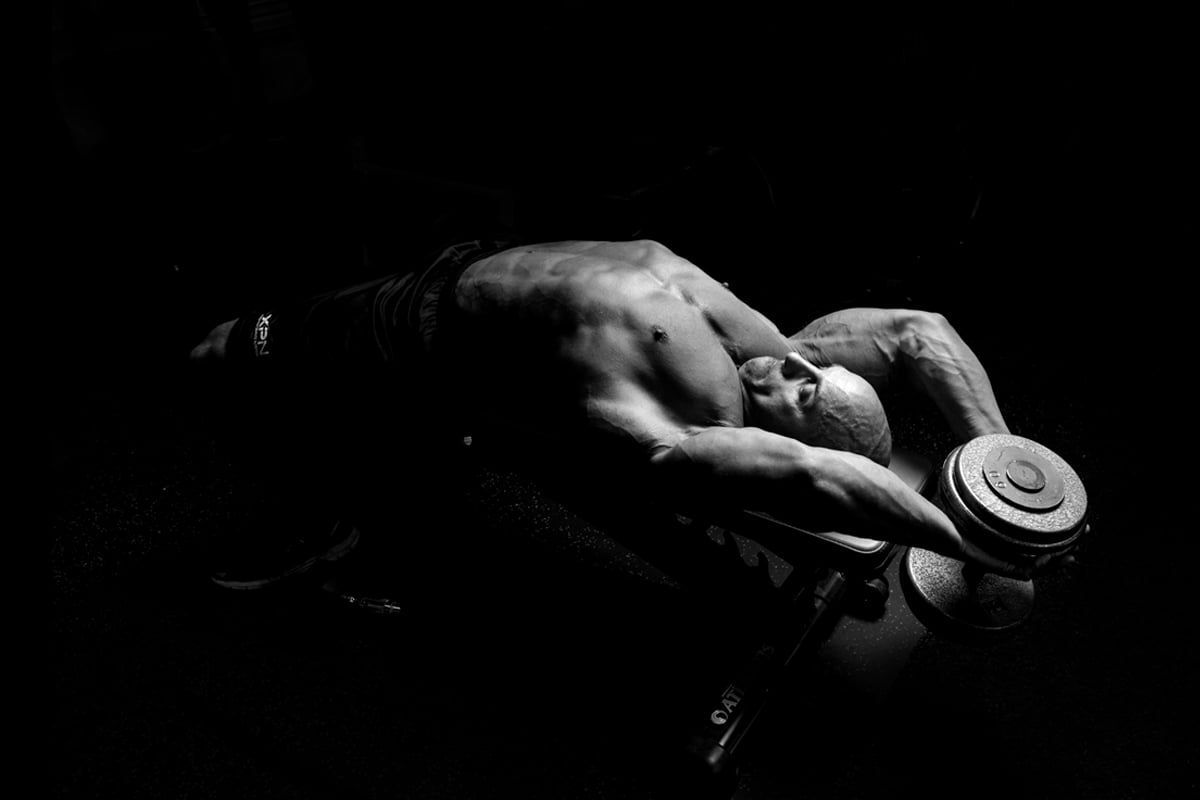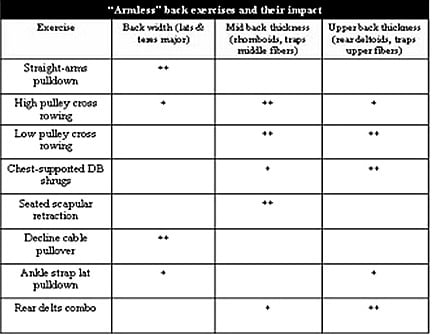Knowledge
The Torso Solution – Back Exercises For People With Strong Arms
Articles, Muscle gain, Strength and performance, Training

Torso People vs. Limb People
Go to a gym, any gym really, and among the clientele with a decent amount of muscle mass, you’re likely to find two types of upper bodies: the torso people and the limb people. Rarely will you see an individual who has both areas of the body developed in perfect balance? In most cases, individuals will fall into one of these categories:
- Chest and back lagging behind the biceps and triceps.
- Biceps and triceps lagging behind the chest and back.
You can also have subcategories where an individual can have:
- Big triceps, lagging chest, big back, lagging biceps.
or… - Big chest, lagging triceps, big biceps, lagging back.
This occurs because our bodies will strive to use the muscles best suited to do the job. For example, suppose someone has very strong arm-flexors (biceps, brachialis, brachioradialis) or is mechanically advantaged in that department. In that case, these muscles will take on more of the workload during heavy pulling movements. As a result, these muscles will then receive more growth stimulation than the back, which only accentuates the problem.
Correct lifting technique also plays a role in proper muscle recruitment. When performing an exercise aimed at building the back muscles, then the arm flexors’ activation should be minimized. However, this isn’t easy to do when the individual already has overpowering arms.
Big Arms/Small Back Syndrome: The Solution
This article will show you several upper back exercises that minimize the involvement of the arm flexors. If you suffer from the big arms/small back syndrome, I recommend using these exercises until your back development catches up. When it does, you’ll be able to return to more traditional back movements since the body will naturally increase the involvement of the back musculature in these exercises.
Understand that these exercises aren’t substitutes for properly executed heavy pulling movements. However, they can be used to bring them back into balance and to learn how to focus on your back muscles during pulling exercises. As such, these exercises can be used both to bring a lagging back up to par and to “teach” your body to properly activate the muscles of the back during heavy pulling movements.
Let’s Get Started!
Exercise 1: Straight-Arm Pulldown
This is my favorite exercise to develop the lats and teres major without involving the biceps. It consists of bringing the arms from a fully extended position in front of your face to your pelvis (while keeping the arms as extended/straight as possible). Focus on keeping the back in a neutral/anatomical position (don’t bend forward).
At the low position, bring the shoulders down (scapular depression), so you’ll get a better peak contraction of the back muscles. You can use various grips for the sake of variation: hammer grip with a rope or a parallel grip bar, a pronated grip, or a supinated grip.
Exercise 2: High Pulley Cross-Rowing with Fixed Elbow Angle
This is a good exercise for the whole upper back musculature, focusing on the rhomboids, rear deltoids, and lower fibers of the traps.
The first key point is to “open up” (stretch) your back in the starting position and to squeeze your shoulder blades together at the fully contracted position. The second key is to keep the elbow bent to a minimum during the pull (to minimize biceps involvement). This angle should be anywhere between 100 and 135 degrees, depending on your limb length.
Exercise 3: Low Pulley Cross-Rowing with Fixed Elbow Angle
This third movement is performed the same way as the preceding one; the only difference is that we’ll use a low-pulley position instead of a high-pulley one. This will emphasize the rhomboids, rear delts (like the preceding exercise), and the traps’ upper and middle fibers.
Exercise 4: Chest-Supported Dumbbell Shrug
This exercise is an incline shrug. Lie face down on a bench holding a dumbbell in each hand and perform a shrugging motion. The higher the incline, the more stress you’ll place on the upper fibers of the traps. As you lower the angle, the middle fibers’ involvement will increase and that of the rhomboids.
Exercise 5: Seated Scapular Retraction
This exercise is similar to the preceding one in that it’s simply a shrugging motion. The difference is that it’s performed in a seated position, making it a horizontal shrug.
Open up the back at the starting position and squeeze the shoulder blades together hard. This exercise focuses on the rhomboids.
Exercise 6: Decline Cable Pullover
This exercise is very similar to the straight-arm pulldown movement explained earlier. It also has the benefit of putting more stress on the lats during a fully stretched position. As a result, the first half of the movement is executed with a more significant contraction of the lats. However, the last portion of the movement is less effective than the last portion of the straight-arm pulldown, so utilizing both exercises can become quite useful for complete lat development with minimal arm involvement.
Exercise 7: Ankle Strap Lat Pulldown
This movement requires the use of an ankle strap attachment that you loop around your arm at the elbow. From a position with the arm above your head, pull your elbow toward the side of your ribcage. You essentially duplicate a lat pulldown movement without having to rely on the arm flexors. This exercise can be done with one or two arms at a time.
Exercise 8: Rear Delt/Rhomboid Raise
I consider the rear deltoid to be part of the upper back complex because of both its function and position on the body. The rear delt raise combo is a good way of finishing off a back workout.
The way you perform the exercise can have a specific impact on muscle recruitment/development. Pictured above are the three different positions that I recommend. I often suggest performing all three positions during a set (five reps of each).
Here’s a chart to help you sort things out:
Sample Programs
Level 1 (Easy)
A. Straight-Arm Pulldown – Pronated Grip
Four sets of 10-12 reps
Controlled tempo; add a 2-3 second peak contraction on each rep
60 seconds of rest
B. Low Pulley Cross-Rowing with Fixed Elbow Angle
Four sets of 8-10 reps
Controlled tempo; add a 2-3 second peak contraction on each rep
60 seconds of rest
C. Rear Delt Combo
Four sets of 12-15 reps (4-5 reps per position)
Controlled tempo
45 seconds of rest
Level 2 (Intermediate)
A. Straight-Arm Pulldown – Hammer Grip
Three sets of 10-12 reps
Controlled tempo; add a 2-3 second peak contraction on each rep
60 seconds of rest
B. Decline Cable Pullover
Three sets of 10-12 reps
Controlled tempo; add a 2-3 second hold at the stretch position on each rep
60 seconds of rest
C1. High Pulley Cross-Rowing With Fixed Elbow Angle
Three sets of 8-10 reps
Controlled tempo; add a 2-3 second peak contraction on each rep
No rest (post-fatigue superset)
C2. Seated Scapular Retraction
3 sets of 12-15 reps
Hold a 2-second pause at the stretch position and a 2-second peak on each rep
90 seconds of rest
D. Rear Delt Combo
Three sets of 12-15 reps (4-5 reps per position)
Controlled tempo
45 seconds of rest
Level 3 (Difficult)
A. Straight-Arm Pulldown – Hammer Grip
Three sets of 10-12 reps
Controlled tempo; add a 2-3 second peak contraction on each rep
60 seconds of rest
B1. High Pulley Cross-Rowing with Fixed Elbow Angle
Three sets of 8-10 reps
Controlled tempo; add a 2-3 second peak contraction on each rep
No rest (post-fatigue superset)
B2. Seated Scapular Retraction
3 sets of 12-15 reps
Hold a 2-second pause at the stretch position and a 2-second peak on each rep
90 seconds of rest
C1. Low Pulley Cross-rowing With Fixed Elbow Angle
Three sets of 8-10 reps
Controlled tempo; add a 2-3 second peak contraction on each rep.
No rest (post-fatigue superset)
C2. Chest-Supported Dumbbell Shrug
Three sets of 12-15 reps
Hold a 2-second pause at the stretch position and a 2-second peak on each rep
90 seconds of rest
D. Rear Delt Combo
Three sets of 12-15 reps (4-5 reps per position)
Controlled tempo
45 seconds of rest
Level 4 (Reintegration of the traditional back exercises)
A1. Chest-Supported Dumbbell Rowing
Three sets of 8-10 reps
Controlled tempo
No rest (post-fatigue superset)
A2. Low Pulley Cross-Rowing with Fixed Elbow Angle
Three sets of 8-10 reps
Controlled tempo; add a 2-3 second peak contraction on each rep
90 seconds rest
B1. Lat Pulldown to the front (or weighted chins)
Three sets of 8-10 reps
Controlled tempo
No rest (post-fatigue superset)
B2. Straight-Arm Pulldown – Pronated Grip
Three sets of 10-12 reps
Controlled tempo; add a 2-3 second peak contraction on each rep
90 seconds of rest
C. Rear Delt Combo
Three sets of 12-15 reps (4-5 reps per position)
Controlled tempo
45 seconds of rest
Kick-Start Your Upper Back!
When your main objective is to build muscle mass, you shouldn’t focus on “lifting weights” instead of contracting muscles against resistance. However, when one muscle group is overpowering another (arms in our case), it can become challenging to get a maximum quality contraction in the back muscles when performing pulling movements. These exercises often become “arm” exercises, the result being that the arms receive even more stimulation while the back remains partially untapped.
Furthermore, continuing this form of training can eventually lead to faulty movement patterns that’ll make it more challenging to efficiently use your upper back musculature. These exercises will help you “re-learn” to use your back so that when you get back to more traditional back training, you’ll be training your back, not your biceps!
Please don’t get the wrong message, though: these exercises serve their purpose, but they aren’t as effective as adequately performed heavy pulling exercises. However, suppose you have trouble getting your back into action during traditional back movements. In that case, these exercises might be the solution to your problem and will help you kick-start your upper back development!
-CT
*Originally posted on www.t-nation.com 01/09/07
